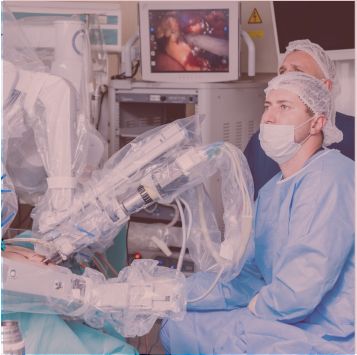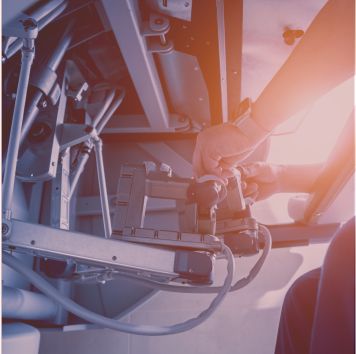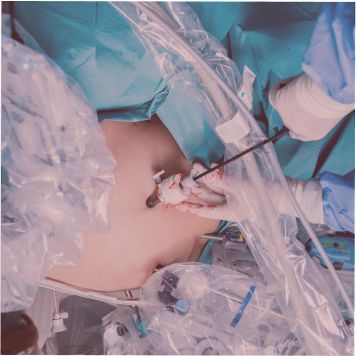Reverse your Tubal Ligation

Untie your tubes NOW - It’s time to reclaim your fertility
Overview
Women who’ve undergone tubal ligation, often referred to as “getting your tubes tied,” sometimes wish to have it reversed. Tubal re-anastomosis, more commonly known as tubal ligation reversal, is the process of reconnecting or untying the fallopian tubes, depending on the method of tubal ligation, to restore the chance of pregnancy. Tubal Reversal surgery is a very safe and very effective operation that has been performed successfully for several decades using open or laparoscopic procedures. However, using robotic surgery in the laparoscopic procedure greatly enhances patient fertility success rates. Dr. Neef performs Tubal Reversals using the da Vinci Robotic Surgical System. During this procedure, he sits at a robotic console where he controls three or four robotic arms to remove the scarred portion of the fallopian tubes. Computer-controlled scaling gives him the ability to visually zoom in and out with a high-definition and three-dimensional visualization to enhance his ability to perform procedures with increased accuracy. He then carefully removes the occluded tubal segments, being careful to only remove as much as necessary. During the Tubal Reversal the damaged section(s) of your fallopian tube(s) is (are) carefully excised using a microscope, leaving only the remaining healthy and open Fallopian tube segments. These segments are then reconnected with extremely fine, hair-like sutures in multiple layers using a microsurgical technique. Careful and meticulous surgery allows Dr. Neef to maintain as much of the original tube as possible, significantly increasing your chances of pregnancy. Open (patent) tubes will once again allow sperm to access and fertilize an ovulated egg in the fallopian tubes.

Benefits
Robotic surgery is a form of minimally invasive laparoscopic surgery that utilizes a computerized robotic arm that the surgeon controls to execute more delicate procedures than the human hand alone can perform. There is much less pain and scarring from Robotic Laparoscopic Surgery than from open surgery. This leads to a higher overall pregnancy rate because the spaces around the tubes are not damaged. The ability of the egg and sperm to meet is much higher when the spaces around the tubes are clear. This procedure is by far the best for the patient, providing several advantages to ensure that you have the best possible outcome. The benefits of this surgical approach are many.
Be free of gynecological pain
Reversing a tubal ligation is the best way to become pregnant again
Tubal re-anastomosis

Microsurgical Tubal Reanastomosis


Robotic Microsurgical Tubal Surgery
Regain Your Fertility
Following tubal ligation, the wish to have more children is the main reason for regret. There are many reasons you had your tubes tied, but the only reason to have them untied is to get pregnant. Now is the time to have a baby. If you are looking for a doctor to reverse your sterilization, Jason Neef, MD, should be your choice.
Patient Care
The robotic laparoscopic tubal reversal is a technique of minimally-invasive surgery. It involves the use of special small instruments for repairing the damaged fallopian tubes. Tubal reversal is a safe procedure, and the risks that are involved in this procedure are also low if you have good reproductive health. The risks associated with the surgery are the same as any procedure involving general anesthesia. There is also a risk of ectopic pregnancy after the tubal reversal, but the risk is not too high. The biggest advantage of tubal reversal is that once you have completed the reversal, you may no longer need any intervention through a physician (such as expensive medications or procedures) in order to get pregnant. Regular intercourse, in time, should lead to a pregnancy. A preoperative consultation with Dr. Jason Neef, MD includes a review of some factors like age, tubal length, and partner’s sperm count before suggesting this surgery.

Why Dr. Neef is
the Best for Surgery
Dr. Jason Neef, MD, performs many surgical procedures for multiple gynecologic problems, but his main focus is on tubal reversal procedures for restoration of fertility. He has undergone additional training to perform reversal tubal ligations (tubes tied). No need to travel miles away from home for an experienced robotic surgeon to perform your tubal reversal. Dr. Neef is a skilled specialist who can untie your tubes close by in the local comfort of your community.

Tubal Reversal is nearby
Proven expertise in robotic surgery for robotic tubal reversal near your home.

FAQ
Most Popular Questions
-
Tubal ligations are typically referred to as tubes being cut, tied, and burned. These procedures are usually very good for reversal. Some forms of sterilization are difficult or impossible to revere such as salpingectomy, where the Fallopian tubes are totally removed.
-
A natural or spontaneous pregnancy after tubal ligation is possible but chances of getting pregnant naturally after a tubal ligation are low. After all, people typically have tubal ligations as a form of permanent birth control.
-
Post operative recovery may take 2-4 weeks, otherwise, you may try as soon as you like.
-
The success rate for conceiving after tubal reversal is approximately 70% for women under 35 and roughly 30% for women in their early-40s.
-
All surgery has some risk. It's rare, but it's possible you could have bleeding, infection, damage to nearby organs, or reactions to anesthesia. Tubal reversal also gives you a higher risk of ectopic pregnancy, a in which a fertilized egg grows outside the uterus.
-
Reversals are usually performed through a small 4-inch incision. The pain that patients feel after pelvic surgery is usually incisional pain; tubal ligation reversals are no different. The smaller the incision, the less the pain you feel.
-
Bipolar Coagulation - uses electrical current to cauterize sections of the fallopian tube. Depending on the number of sites coagulated, tube damage is typically only 2 or 3 centimeters in length and pregnancy rates after reversing this procedure are about 70%.
Irving Procedure - This procedure calls for placing two ligatures (sutures) around the fallopian tube and removing the segment of tubing between the ligatures. Then to complete the procedure, the ends of the fallopian tubes are connected to the back of the uterus and the connective tissue respectively. Fortunately, this procedure usually leaves two healthy fallopian tube sections and a pregnancy rate of around 70% on average.
Tubal Clip - The silastic band or tubal ring method involves a doubling over of the fallopian tubes and application of a silastic band to the tube. Pregnancy success rates can also be very high with this method if only a small portion of the tube is damaged by the rings.
Pomery Tubal Ligation - In this method of tubal ligation, a loop of tube is “strangled” with a suture. Usually, the loop is cut and the ends cauterized or “burned”. This type of tubal ligation is often referred to as cut, tied, and burned. These are usually very good for reversal.
Essure - In this method of tubal ligation, two small metal and fiber coils are placed in the fallopian tubes. After insertion, scar tissue forms around the coils, blocking off the fallopian tubes and preventing sperm from reaching the egg.
Adiana - two small silicone pieces are placed in the fallopian tubes then small portion of each fallopian tube is heated. After the procedure, scar tissue forms around the silicone inserts, blocking off the fallopian tubes and preventing sperm from reaching the egg.
Monopolar Coagulation - uses electrical current to cauterize the tube together, but also allows radiating current to further damage the tubes as it spreads from the coagulation site. Due to the fallopian tube damage from this procedure, pregnancy rates drop to approximately 45%.
Fibriemectomy – removes a portion of the fallopian tube closest to the ovary, eliminating the ovary’s ability to capture and transfer eggs to the ovary. This procedure has the lowest success rates and repair is therefore not recommended.
-
Tubal ligation does not affect hormones or the appetite, it does not induce weight gain.
-
The best chances of success involve rejoining two parts of the tube of similar diameters. Moreover, the Fallopian tubes are typically 8 inches long, and women who have a minimum of 4 inches of tube after the re-joining procedure have the highest pregnancy success rates after a tubal reversal procedure.
-
Insurance doesn't typically cover the procedure unless medically necessary.


